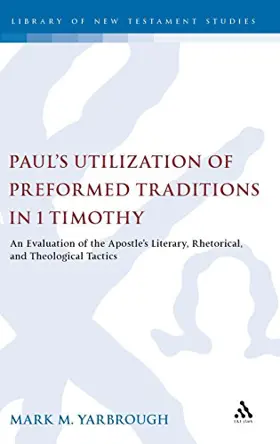

Paul's Utilization of Preformed Traditions in 1 Timothy: An evaluation of the Apostleâ
in Library of New Testament Studies
Pages
256
Publisher
T&T Clark
Published
2/10/2010
ISBN-13
9780567254900
Mark Yarbrough assesses the question of whether traditional ‘preformed' material contributes to the message and understanding of Paul's first letter to Timothy. The issue is addressed in three sections. Part one evaluates previous works interacting with ‘traditional' material in the New Testament. Through a critique of historically proposed criteria, Yarbrough identifies eight criteria as the primary tools by which to discern units of preformed material.
In the second part of the book Yarbrough evaluates nineteen passages in 1 Timothy according to the criteria previously determined. From this base he embraces twelve of the nineteen passages as preformed material. These passages are subsequently examined in depth according to the author's distinct methodology. Part three demonstrates four functions of the preformed traditions in 1 Timothy. Firstly, that they may be seen as strengthening the literary cohesion of the letter. Secondly, that the traditional units afford the author rhetorical leverage which may be best identified as the provision of authority, the establishment of an instant rapport with the primary audience, and the assistance conferred in addressing this implied audience. Thirdly, they present theological directives that confront the character and belief of the false teachers.
Finally, Yarbrough asserts that the preformed traditions exist as a combatant against counter-mission doctrine. In conclusion, this study displays that the traditional material which may be discerned within the letter contributes significantly to the overall message and understanding of 1 Timothy.
In the second part of the book Yarbrough evaluates nineteen passages in 1 Timothy according to the criteria previously determined. From this base he embraces twelve of the nineteen passages as preformed material. These passages are subsequently examined in depth according to the author's distinct methodology. Part three demonstrates four functions of the preformed traditions in 1 Timothy. Firstly, that they may be seen as strengthening the literary cohesion of the letter. Secondly, that the traditional units afford the author rhetorical leverage which may be best identified as the provision of authority, the establishment of an instant rapport with the primary audience, and the assistance conferred in addressing this implied audience. Thirdly, they present theological directives that confront the character and belief of the false teachers.
Finally, Yarbrough asserts that the preformed traditions exist as a combatant against counter-mission doctrine. In conclusion, this study displays that the traditional material which may be discerned within the letter contributes significantly to the overall message and understanding of 1 Timothy.
- Table Of Contents
- 1. Introduction (Scope, Focus, Need, Organization, Limitations)
- 2. Taxonomy and Identification Criteria for Preformed Traditions
- Taxonomy
- Pauline Taxonomical Examples
- Identification Criteria
- Synthesis and Preferential Criteria
- Methodology of Criteria Identification and Evaluation
- Method of Evaluation
- 3. Identification of Preformed Traditions in 1 Timothy
- 1 Timothy Chapter 1
- 1 Timothy Chapter 2
- 1 Timothy Chapter 3
- 1 Timothy Chapter 4
- 1 Timothy Chapter 5
- 1 Timothy Chapter 6
- 4. Paul's Utilization of Preformed Traditions in 1 Timothy
- Preformed Traditions and the Strengthening of Literary Cohesion
- Preformed Traditions and the Provision of Rhetorical Leverage
- Preformed Traditions and the Presentation of Theological Directives against the Opponents
- Preformed Traditions and the Argument of 1 Timothy: Combat Counter-Mission Doctrine
- 5. Conclusion